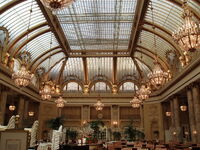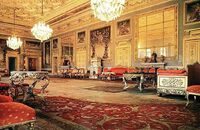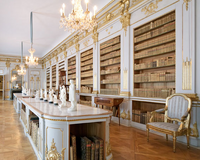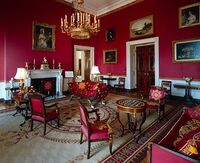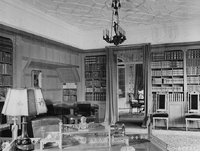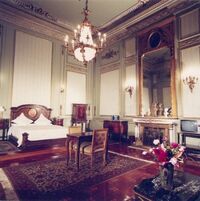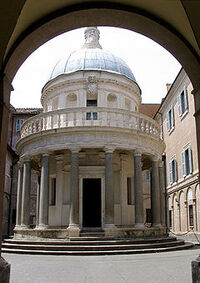| Realpaleis | |
|---|---|
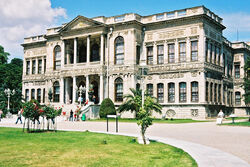
| |
| National Monument | |
| Location | Grafstad, Koningstad |
| Type(s) | Cultural |
| Selected | 1955 |
The Realpaleis (English: Royal Palace) is the official residence of the Royal Family in Koningstad, Brunant. It is located at Koningstraat 11, Grafstad. Construction began on the palace in 1772 and work continued through the years until 1870. It is a National Monument.
History[]
Early history[]
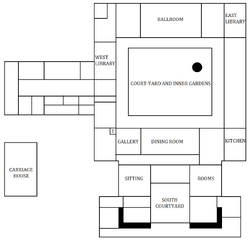
The Realpaleis' site was originally a large park and plaza in the center of the Grafstad area. In 1713, the land was purchased by the family Graf, which had envisioned building houses on the land and renting them out. A few houses were built, but never in the quantity envisioned by the family. But falling into debt, the land was eventually forfeited to the local authorities in exchange in 1743. The land remained unused for decades and it was eventually purchased by King Pieter I in 1764; by then his hunting lodge (Steenhuis Manor) had been sold and the Royal Family had outgrown Koningsberg Palace, their only summer retreat.
Construction[]
Due to high state debts following the Franco-Brunanter War, construction of the palace only began in 1772. Italian architect Manuele Bellini (1711-1778) was hired to design the palace and supervise the work. Bellini had envisioned a sprawling palace like the Hofburg in Vienna or Versailles in France. But he was displeased when he arrived as he only had a small area to work with. Bellini's plan was thus for a smaller palace without the excesses of other 18th-century residences. Bellini spent most of his time having the park cleared and the buildings on the land destroyed. The foundations for the palace (the groundbreaking) only began in the spring of 1775.
Balyan's plan[]
Bellini died in 1778 and he was succeeded by the Ottoman architect Mehmet Balyan (1701-1788). Balyan, while sticking to Bellini's plan, completely changed the detail and decoration of the palace and gave it the oriental-inspired facade seen on the south entrance. Balyan oversaw the completion of much of the exterior, but work was stopped following Carrington's invasion of Brunant in 1784.
Palace decay[]
Carrington, who was initially opposed to the monarchy was unwilling to let construction resume and the new king, Adrian II, spent his days out of the public eye in Grijzestad. Also, the man in charge of building a new Koningstad, Victor Janowicz, famously omitted this palace from his "master plan" and it was believed it would be torn down. Balyan, enraged and displeased left for Istanbul shortly after, as he was not paid for his most recent work. Finally, in 1787 Janowicz had decided to keep the Grafstad neighborhood as was, and Carrington had made it clear he intended to keep the monarchy, but in the new capital at Koningstad. Thus work was set to begin and Mehmet Balyan was asked to return. The aging Balyan agreed to return to finish work on the palace, but died just weeks before his intended voyage on May 1788.
Le Maitre's work[]
Following Balyan's death, Alexandre Le Maitre, the architect working on the Koningsberg Palace restoration was selected to finish the final work. As his secondary project, work on the Realpaleis was very slow. With costs rising on his other project (which was deemed more important), work did not progress well, despite the Royal Family moving to the palace in 1792. Le Maitre, who was raking up huge expenses on Koningsberg Palace was relieved of his work here (in 1795) as costs began to mount. The palace, though not fully finished, would be left in the same state for many years.
19th century expansion and completion[]
In 1831, Edward Blore (later known for his work on Buckingham Palace) was selected to renovate and complete the Realpaleis. Throughout the 19th century, the palace was increasingly in bad state and many rooms were left abandoned. Blore, using Balyan's old plans, was able to quickly complete the exterior work by 1835. Work on the interior recommenced in 1833 and by 1840, it was largely finished. He began working on the gardens in 1836 and by 1844, he had bushes, flowers and fountains installed in both the courtyard and the palace grounds. When Blore ended his work in 1845, over 90% of Balyan's original plan was complete. Brunanter architect Willem Montburg (1808-1874) was hired to finish Blore's work. The palace was officially completed in October 1848.
But, by the 1860s, the family and their needs had outgrown the 18th century design and there was a need for more room. Montburg was brought back in 1863 to add a new wing to the palace. Work went by rather quick and it was completed in 1870. He also added a carriage house on the grounds, which would be the last major construction done to the palace.
Modern history[]
In 1891, the Royal palace became the second building in Koningstad to have a telephone, which would be added in a special telephone-room. In 1900, the first electric lighting would be installed, although the palace would not be fully electrified until 1914. In 1926, a fire broke through the garage, destroying two cars and causing some damage to the gardens.
During the Battle of Koningstad, the palace sustained some damage to the northern side. During the ensuing occupation the palace was used as a staff headquarter and later served as a hospital for German soldiers from 1943-44. Much of the palace's treasures were looted and many would never be returned. In 1944, the Royal Family returned to Brunant and were temporarily housed at Koningsberg Palace while work was being done to the palace. The family returned to the palace in 1950, although work continued until 1955.
In early 2018 a large portion of the interior was renovated by NP interior, led by designer Beatriz Navarro Penrose.
Rooms[]
State Dining Room[]
The State Dining Room is the official dining room in the palace. The dining room was first built from 1782-84, but the work was stopped in 1784. Work on the dining room recommenced in 1834 under Blore and was completed in 1837. It is under a magnificent glass dome built by A.C. Van Gernam in 1869, replacing an earlier glass roof which collapsed in 1866. Currently, the dining room is used for dinner parties and to host dignitaries; the Royal Family eats daily at a modest room on the second floor.
Ballroom[]
The ballroom is one of the biggest rooms in the palace. The ballroom, while laid out in Balyan's plan was not completed while he was in charge, and Le Maitre only made a simple fix-up. While adding a lot of detail to the room (seen with the lamps and mirrors), designer Francesco Brighi kept a general simplicity to the room. The ballroom was the center of life in Koningstad and was home to lavish parties in the 19th and early 20th century. Nowadays, it is most often used as the throne room and where the King officially receives guests.
Libraries[]
The palace has two libraries, the East library and the West library. The West library houses the collection of King Ambroos I's books, built up over the 18th and 19th centuries. The East library is smaller and contains books given to the Royal Family by other dignitaries, friend and members of the public. Both these rooms have been decorated in an 18th century style, modeled after Russian palaces.
Koninginnehal[]
The Koninginnehal (English: Queen's Hall) is the Queens's sitting and reception room, built in the 1780s. This magnificent red room was often used to host dignitaries or other important visitors of the Queen. Since the 1950s, the room has become the Queen's personal office and is rarely used to entertain guests.
King's office[]
The King's office is where the King of Brunant sits down to work. The office was completed in 1791 and it has been the place where the King spends much of his time. Since the 1820s, each King has started a tradition of redecorating the office to their taste. The largest such work was done in 1884, when Pieter II had the room done in a northern European style with wood and thick carpeting. This was removed by Johan II in 1921, who preferred a more colorful and lighter Mediterranean look, which has since remained in place. Helene of Brunant became the first female monarch to use the room. Its current name is Queen's office.
The apartments[]
The apartments comprises the western section of the palace on the second floor. This is where the Royal Family resides though most of the year. There are six large rooms and several bathrooms, which are used by the family.
Royal bedroom[]
The Royal bedroom is the bedroom used by the King and Queen of Brunant. Built from 1779 onward, it was only completed in 1836. The current decorations are from Cristian I's reign, added in 1850. The room is rather simple when compared to other monarchs' bedrooms; the only special amenity is a color television set added in 1970.
Second floor[]
The rest of the second floor consists of rooms used by the Royal Family for personal affairs. They include the large family room, their everyday dining room and other private rooms.
Gardens[]
The palace is known for its large and beautiful gardens. Most of the plants and vegetation are located on the palace grounds overlooking Koningstraat, Carrington Avenue and the Grotestraat. There are also two courtyards which have their own gardens. Here, one can find the Royal Mausoleum and other beautiful fountains.
Royal Mausoleum[]
The Royal Mausoleum was built in 1800 to house the coffins of King Karl Van Draak and Isabella of Parma. The couple were placed in a special round pavilion in the central courtyard. Underground, more space was created and with Ambroos I's death in 1823 more Kings and Queens have been buried here.
Visiting the palace[]
See also: Realpaleis website
The Realpaleis is open year round to visit from 10:00 to 17:00, except during Sundays, national holidays and other important occasions. Admission to the palace is 10€ for adults and 8€ for students and elderly. Children under 15 visit free of charge and ExploreBT cardholders can enter for half price.
The palace is accessible by bus and is located near the Realpaleis station, served by both the S3 and S4 lines of the Koningstad S-train.
See also[]
| Royal residences |
| Current: Realpaleis • Grijzestad Palace • Huis ten Bergen Former and unused: Bitburg Castle • Koningsberg Palace • Leuvisberg Castle • Steenhuis Manor |
